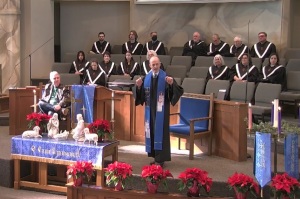High Court Splits on Ten Commandments Displays
The Supreme Court on Monday upheld the constitutionality of Ten Commandments displays on government land but not inside courthouses.
The Supreme Court on Monday upheld the constitutionality of Ten Commandments displays on government land but not inside courthouses.
The two opposite rulings, made within hours of one another, mark the first time in a quarter century that the High Court took up the volitile church-state issue.
In the first case, the Justices ruled 5-4 that framed Ten Commandments displays in two Kentucky state courthouses violate the doctrine of separation of church and state. However, they clarified that the ruling does not apply to all Ten Commandments displays and that in some instances – like the dozens of exhibits in their own courtroom – the monuments are legitimate symbols of the nation’s religious and legal history.
“The touchstone for our analysis is the principle that the First Amendment mandates government neutrality between religion and religion, and between religion and nonreligion," Justice David H. Souter wrote for the majority.
The second case involved a 6-foot granite monument of the Ten Commandments on the grounds of the Texas capitol. In a 5-4 ruling, the justices found the monument, which is one of 17 historical displays on a 22-acre lot, did not endorse religion.
"Of course, the Ten Commandments are religious — they were so viewed at their inception and so remain. The monument therefore has religious significance," Chief Justice William H. Rehnquist wrote for the majority in the case involving the display outside the state capitol of Texas.
In Kentucky, two counties in 1999 hung the copies of the Ten Commandments in their courthouses. After the ACLU filed suit in McCreary County v. ACLU of Kentucky, the counties added other documents demonstrating “America’s Christian heritage,” including the national motto of “In God we Trust.”
In a dissenting voice to the Kentucky case, Justice Antonin Scalia wrote that while the displays’ initial motive may have been religious, the effort to dilute that specific message by hanging other historical documents in the courthouses later made the Ten Commandments display legitimate.
"In the court's view , the impermissible motive was apparent from the initial displays of the Ten Commandments all by themselves: When that occurs: the Court says, a religious object is unmistakable," Scalia wrote. "Surely that cannot be."
The Texas case involved an exhibit donated by the Fraternal Order of Eagles in 1961. The group gave thousands of similar monuments to American towns throughout the 1950s and ‘60s.
Both cases were initially heard by the Supreme Court on March 2.
Meanwhile, Mathew D. Staver, President and General Counsel of Liberty Counsel, who argued for the displays in the Kentucky case in March, said the “battle is far from over.”
“Today’s decision is historic and will have a significant impact on the future court decisions regarding the interaction between church and state,” Staver wrote in a statement. “That the Ten Commandments would be deemed unconstitutional is an insult to the Constitution, to our shared religious history and to our Veterans from whose blood liberty was birthed.
“Our Constitution need not be amended to remedy today’s decision. Our Constitution is sound. We need to judges who understand the rule of law and who respect the Constitution.”
According to the latest AP-Ipsos poll, Ten Commandments displays are supported by a majority of Americans. The poll, taken in late February, found that 76 percent support and 23 percent oppose them.




























